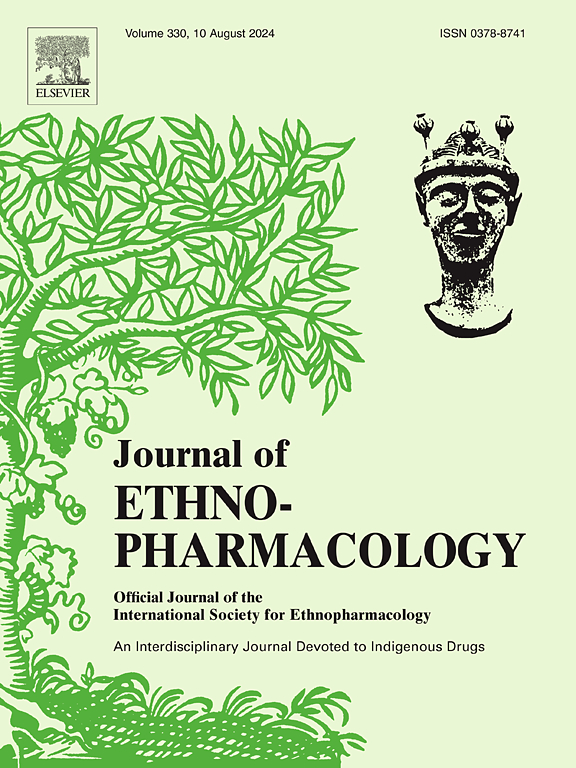Discovering the Q-marker of scutellaria baicalensis against viral pneumonia integrated chemical profile identification, pharmacokinetic, metabolomics and network pharmacology
IF 4.8
2区 医学
Q1 CHEMISTRY, MEDICINAL
引用次数: 0
Abstract
Ethnopharmacological relevance
Scutellaria baicalensis (SR), an ancient antiviral herbal medicine, is widely used in treating viral pneumonia and its active constituents, baicalin and baicalein, have been reported to have antiviral activity.
Aim of the study
However, reports on Q-markers of SR for antiviral pneumonia are still scarce. This study aims to screen for Q-markers using a comprehensive strategy that integrates identification of chemical profiles, in vivo absorption, metabolic regulation and predicted target.
Materials and methods
First, the markers were screened by chemical profile identification and pharmacokinetics using HPLC-MS/MS. Then, the therapeutic effects and differential metabolites of SR on viral pneumonia rats were evaluated by HE staining, assessment of inflammation levels and metabolomics analysis. Finally, the mechanisms of action between Q-markers and metabolites were exploited based on network pharmacology.
Conclusion
A total of 139 compounds were identified in SR, of which 35 and 41 were found in rat plasma and urine, respectively. Pharmacokinetic screening identified baicalin, baicalein, wogonin, wogonoside and oroxylin A as potential markers of SR. Furthermore, SR significantly improved interstitial and alveolar oedema, hemorrhage and alveolar collapse after modelling, while reducing the expression of inflammatory factors. Metabolomics revealed that SR significantly regulated the expression of 37 metabolites, mainly involving phenylalanine, tyrosine and tryptophan biosynthesis pathways. Network pharmacology showed that these five biomarkers can regulate the expression of metabolites through the key target SRC, ESR1, HSP90AA1, EGFR, thereby exerting antiviral effects against pneumonia. The study results suggest that baicalin, baicalein, wogonin, wogonoside and oroxylin A serve as primary Q-markers of SR in the treatment of viral pneumonia.

综合化学谱鉴定、药代动力学、代谢组学和网络药理学发现黄芩抗病毒性肺炎q标记。
民族药理学相关性:黄芩是一种古老的抗病毒草药,被广泛用于治疗病毒性肺炎,其有效成分黄芩苷和黄芩苷已被报道具有抗病毒活性。研究目的:然而,关于抗病毒肺炎SR q标记物的报道仍然很少。本研究旨在利用综合鉴定化学特征、体内吸收、代谢调节和预测靶标的综合策略筛选q标记物。材料与方法:首先,采用HPLC-MS/MS进行化学谱鉴定和药代动力学筛选。然后通过HE染色、炎症水平评估和代谢组学分析,评价SR对病毒性肺炎大鼠的治疗效果和差异代谢物。最后,基于网络药理学探讨了q标记物与代谢物之间的作用机制。结论:共鉴定出139种化合物,其中在大鼠血浆和尿液中分别发现35种和41种。药代动力学筛选发现黄芩苷、黄芩苷、枸杞苷、枸杞苷和oroxylin A是SR的潜在标志物。此外,SR在造模后显著改善了间质和肺泡水肿、出血和肺泡塌陷,同时降低了炎症因子的表达。代谢组学结果显示,SR显著调节了37种代谢物的表达,主要涉及苯丙氨酸、酪氨酸和色氨酸的生物合成途径。网络药理学研究表明,这5种生物标志物可通过关键靶点SRC、ESR1、HSP90AA1、EGFR调控代谢物的表达,从而对肺炎发挥抗病毒作用。本研究结果提示黄芩苷、黄芩苷、枸杞子苷、枸杞子皂苷、欧oxylin A可作为SR治疗病毒性肺炎的主要q -标志物。
本文章由计算机程序翻译,如有差异,请以英文原文为准。
求助全文
约1分钟内获得全文
求助全文
来源期刊

Journal of ethnopharmacology
医学-全科医学与补充医学
CiteScore
10.30
自引率
5.60%
发文量
967
审稿时长
77 days
期刊介绍:
The Journal of Ethnopharmacology is dedicated to the exchange of information and understandings about people''s use of plants, fungi, animals, microorganisms and minerals and their biological and pharmacological effects based on the principles established through international conventions. Early people confronted with illness and disease, discovered a wealth of useful therapeutic agents in the plant and animal kingdoms. The empirical knowledge of these medicinal substances and their toxic potential was passed on by oral tradition and sometimes recorded in herbals and other texts on materia medica. Many valuable drugs of today (e.g., atropine, ephedrine, tubocurarine, digoxin, reserpine) came into use through the study of indigenous remedies. Chemists continue to use plant-derived drugs (e.g., morphine, taxol, physostigmine, quinidine, emetine) as prototypes in their attempts to develop more effective and less toxic medicinals.
 求助内容:
求助内容: 应助结果提醒方式:
应助结果提醒方式:


